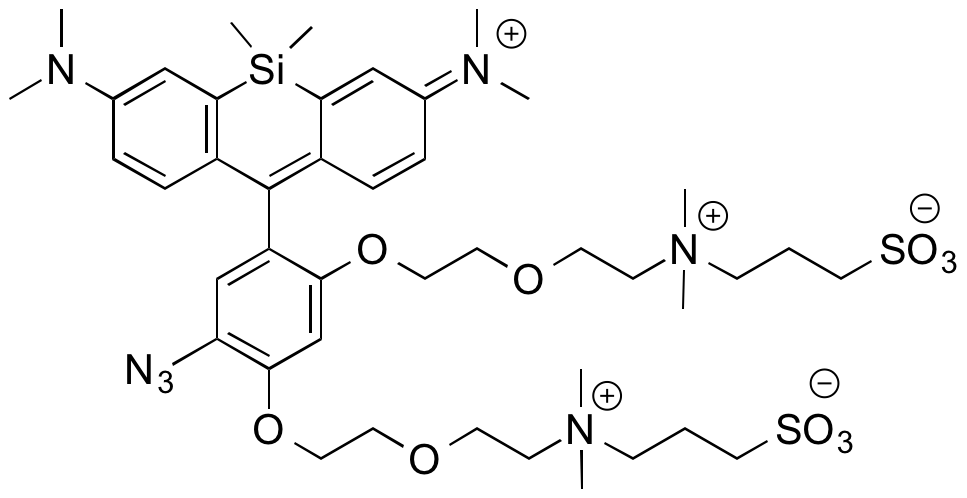CalFluor 647 Azide
Abs/Em Maxima, triazole after click reaction: 657/674 nm
Spectrally Similar Dyes: Alexa Fluor? 647, CF? 647, DyLight? 649, Cy5
CalFluor 647 Azide is a fluorogenic azide probe that is activated by Cu-catalyzed or metal-free click reaction. This azide probe is not fluorescent until it is reacted with alkynes. CalFluor 647 Azide is a water-soluble probe, and its excitation band is a good match for the 633 nm or 647 nm laser lines.
A major shortcoming of the visualization of alkyne-tagged biomolecules with fluorescent azide probes through CuAAC is the need to remove unreacted fluorescent probes. This is particularly problematic when imaging the intracellular environment, tissues of living organisms, or visualizing biomolecules in vivo. Failure to remove all unreacted fluorescent probes is also one of the major contributors to background signal and non-specific binding.
To overcome this shortcoming, Carolyn Bertozzi’s group has designed fluorogenic azide probes that are activated by Cu-catalyzed or metal-free click chemistry. These azide probes are not fluorescent until they react with alkynes. Termed the CalFluors, these probes possess emission maxima that range from green to far-red wavelengths, and enable sensitive biomolecule detection under no-wash conditions. A number of reports show that CalFluor probes are an indispensable tool for sensitive visualization of metabolically labeled molecules (glycans, DNA, RNA, and proteins) in cells, developing zebrafish, and mouse brain tissue slices under no-wash conditions.

1. Shieh P., et al. (2015). CalFluors: A Universal Motif for Fluorogenic Azide Probes across the Visible SpectrumJ. Am. Chem. Soc., 137: 7145?51. [PubMed]
2. Pawlak, J. B., et al. (2016). The Optimization of Bioorthogonal Epitope Ligation within MHC?I Complexes. ACS Chem. Biol., 11: 3172?8. [PubMed]
3. Jun Kit Ow, M., et al. (2020). Super-Resolution Fluorescence Microscopy Reveals Nanoscale Catalytic Heterogeneity on Single Copper Nanowires. ACS Appl. Nano Mater.,, 3, 4, 3163–7. [ACSPublications]
Abs/Em Maxima: 346/445 nmExtinction Coefficient: 19,000Spectrally Similar Dyes: Alexa Fluor? 350, CF? 350, DyLight 350, AMCAAZDye? 350 is a blue-fluorescent azide-activated probe that reacts with terminal alkynes via a copper-catalyzed click react…
Abs/Em Maxima: 402/424 nmExtinction Coefficient: 35,000Flow Cytometry Laser Line: 405 nmMicroscopy Laser Line: 405 nmSpectrally Similar Dyes: Alexa Fluor? 405, CF? 405, Cascade Blue?, DyLight? 405AZDye? 405 Azide is a water-soluble, pH-insensiti…
Abs/Em Maxima: 346/445 nmExtinction Coefficient: 19,000Spectrally Similar Dyes: Alexa Fluor? 350, CF? 350, DyLight 350, AMCAAZDye? 350 Alkyne (Alexa Fluor? 350 Alkyne equivalent) is a blue-fluorescent, alkyne-activated probe that reacts with azid…
Abs/Em Maxima: 430/537 nmExtinction Coefficient: 15,000Spectrally Similar Dyes: Alexa Fluor? 430, CF? 430AZDye? 430 Azide is a water-soluble, green-fluorescent azide-activated probe that reacts with terminal alkynes via a copper-catalyzed click re…
Abs/Em Maxima: 346/445 nmExtinction Coefficient: 19,000Spectrally Similar Dyes: Alexa Fluor? 350, CF? 350, DyLight 350, AMCAAZDye? 350 DBCO reacts with azides via a copper-free “click chemistry” reaction to form a stable triazole and does not re…
Abs/Em Maxima: 402/424 nmExtinction Coefficient: 35,000Flow Cytometry Laser Line: 405 nmMicroscopy Laser Line: 405 nmSpectrally Similar Dyes: Alexa Fluor? 405, CF? 405, Cascade Blue?, DyLight? 405AZDye? 405 Alkyne reacts with azides via a copper…
Abs/Em Maxima: 494/517 nmExtinction Coefficient: 73.000Flow Cytometry Laser Line: 488 nmMicroscopy Laser Line: 488 nmSpectrally Similar Dyes: Fluorescein, Alexa Fluor? 488, CF? 488A, DyLight? 488, Atto? 488AZDye? 488 Azide (Alexa Fluor? 488 Azi…
Abs/Em Maxima: 402/424 nmExtinction Coefficient: 35,000Flow Cytometry Laser Line: 405 nmMicroscopy Laser Line: 405 nmSpectrally Similar Dyes: Alexa Fluor? 405, CF? 405, Cascade Blue?, DyLight? 405ZDye? 405 DBCO reacts with azides via a copper-fr…

